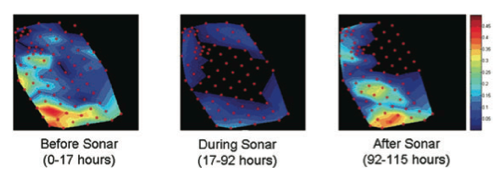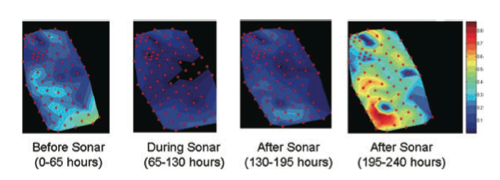More detailed confirmation that beaked whales move away from sonar exercises
Science, Sonar Add commentsThis post is an AEI lay summary of the following paper:
McCarthy, Moretti, Thomas, DiMarzio, Morrisey, Jarvis, Ward, Izzi, Dilley. Changes in spatial and temporal distribution and vocal behavior of Blainville’s beaked whales (Mesoplodon densirostris) during multiship exercises with mid-frequency sonar. Marine Mammal Science, Volume 27, Issue 3, July 2011.
For the past several years, ongoing research at the US Navy’s AUTEC training range in the Bahamas has been providing data that confirms what many had long suspected: that beaked whales move away from active sonar transmissions. A recent paper published in Marine Mammal Science quantifies the changes in more detail than has occurred before.
Using recordings from the permanently-installed hydrophones lining the seafloor of AUTEC, the researchers charted the foraging vocalizations of Blainville’s beaked whales before, during, and after extended Naval training exercises (85 hours in 2007, 65 hours in 2008). In 2007, when activity was high prior to the exercises, animals returned to the range in somewhat lower numbers within 24 hours:

in 2008, when there was less activity prior to the exercises, very few animals returned in the first three days, but many were there shortly thereafter:

Among animals who continued foraging while sonars were nearby, they appeared to tolerate received levels ranging from 101 to 157db, which correlate to sonar transmisisons from ships 2-28km away. A key question considered is whether the animals left the area, ceased vocalizing, or were masked by the exercise sounds. Because of the way that vocalizations increased first around the edges of the range, moving toward the center, the researchers are confident that the animals predominantly left the range; the decreased levels of vocalizations even around the edges imply that most animals moved more than 6km from the range (the limit of confidently knowing they’ll be heard by hydrophones along the perimeter).
The paper concludes by summarizing related ongoing research, including studies that aim to determine whether decreased foraging, especially directly after exercises, is due to fewer beaked whales in the area, or less preay (ie, was the prey moved off the range by the exercise activity and noise?). The authors also note many as-yet unanswered questions that are triggered by their results, including whether the displaced animals continue feeding elsewhere during their absence from the range, and whether this particular population is more habituated to the sonar sounds, so that they either tolerate it better or are less apt to exhibit the presumably more dangerous behavioral responses that lead to strandings.
